111 Search Results for rating scale
November 30, 2020
by Carole Zangari -
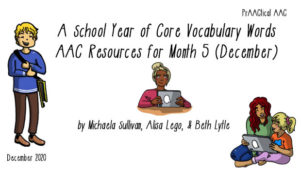
As we prepare to turn the calendar to a new page, take a look at the fifth post in the School Year of Core Vocabulary Words series which is replete with resources for December core words. Guest authored by Michaela Sullivan, Alisa Lego, and Beth Lytle, this series focuses on a selected set of words along with a suggested order in which to teach them. The Activity Packets, containing sheets on highlighting these words in a variety of activities, and Data Collection Forms. In today’s post, they focus on ensuring that the AAC system is available all throughout the day. New to this series? Check out the guest authors’ overview here. Happy reading! A SCHOOL YEAR OF CORE WORDS: DECEMBER by Michaela Sullivan, Beth Lytle, & Alisa Lego To the parents, teachers, Speech-Language Pathologists, Paraprofessionals, friends, and other curious professionals or communicators – welcome back to the monthly School Year... [Read More...]
November 2, 2020
by Carole Zangari -
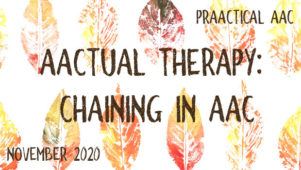
Effective AAC interventionists know the importance of being skilled in using a number of different strategies and techniques for building language. So we’re pleased that SLPs Kate Grandbois and Amy Wonkka are making a return visit to talk more about their favorite therapy strategies and how to apply them to AAC skill-building. In today’s post, they discuss the use of chaining in teaching individuals with AAC needs. You can see their previous post here. Also, don’t miss the link to their podcast at the end, especially if you are interested in earning CEUs for listening. :::::::::::::::::::::::::::::::::::::::::::::::::::::::::::::::::::::::::::::::::::::::::: Bringing it all Together, Episode 2: Chaining in AAC As we mentioned in our previous article, most SLPs have come across popular AAC interventions, like aided language modeling. But there are other interventions, like chaining, that don’t quite get the time in the limelight that they deserve. Chaining is one of these interventions. Chaining... [Read More...]
September 24, 2020
by Carole Zangari -
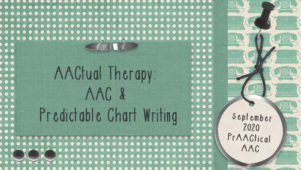
Predictable chart writing is one of my favorite ways to get kids who are new to writing comfortable with a writing routine. Today, our guest author Ashley Larisey shares detailed information that will help you implement this well and have fun doing it. And she helps us understand how to do this successfully in remote teaching. Ashley is an SLP at Community High School District 218 in Oak Lawn, Illinois. She is also an Adjunct Clinical Supervisor and Instructor at Saint Xavier University. In today’s post, she breaks down the steps of using predictable chart writing, points us to relevant resources, and provides a video overview of the process. Enjoy! :::::::::::::::::::::::::::::::::::::::::::::::::::::::::::::::::::::::::::::::::::::::::::::::::::::::::::::::::::::::: Predictable Chart Writing As many educators look for new and innovative ways to bring comprehensive literacy instruction into their practice, one of the first strategies that comes up in a quick google search is Predictable Chart Writing (PCW). PCW... [Read More...]
September 14, 2020
by Carole Zangari -
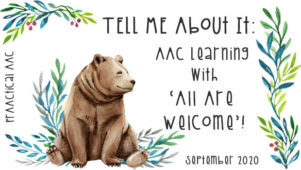
Welcome to Year 2 of the TELL ME About It series, guest authored by Jeanna Antrim and Maggie Judson. For the past year, they’ve written monthly articles to discuss how they support preschool teachers who are implementing the TELL ME program with their young students. Maggie and Jeanna are speech-language pathologists who work in the Assistive Technology Department for the Belleville Area Special Services Cooperative (BASSC) in southern Illinois. They are AT/AAC facilitators and provide evaluations, direct therapy, consultations, and trainings with school teams. In Year 1 of this series, Jeanna and Maggie focused on the 11 books in the TELL ME program. In each of those posts, they shared a lesson plan, activity suggestions, video demonstrations, and much more. You can see their previous posts in the TELL ME About It series below. Max’s Breakfast If You’re Angry and You Know It The Lunch Box Surprise Come Out and Play, Little... [Read More...]
August 29, 2020
by Carole Zangari -
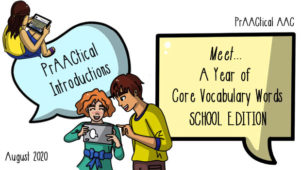
Much has changed since we first wrote about the Year of Core Vocabulary Words and began publishing monthly word lists, symbol cards, activity ideas, and book suggestions. It is gratifying to see the concept and these resources being used by teachers, clinicians, and parents. Today, we introduce an expansion of that concept with a specific focus on school-based AAC support. Say hello to the School Year of Core Words series. Conceptualized and created by AAC SLP Michaela Sullivan, and two pre-professional SLP students, Beth Lytle and Alisa Lego, the series begins with this introduction to the Level 1 and Level 2 words, and some information about what to expect as the series progresses. It will be followed by monthly posts with ideas, resources, and materials. The series follows a US academic calendar, running from August through June. You can learn more about the School Year of Core Word series creators,... [Read More...]
August 27, 2020
by Carole Zangari -
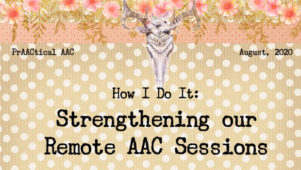
As online instruction and therapy continue to be an important service delivery option, practitioners are growing their skills and expanding their toolboxes. Today, we welcome back PrAACtical AAC contributor Sarah Gregory with more tips and suggestions for how to make these virtual sessions more engaging and productive. Sarah is an AAC SLP and AT Specialist in Ithaca NY where she supports students in public school settings. In this post, she shares tips, videos, and activity downloads for AAC telepractice. :::::::::::::::::::::::::::::::::::::::::::::::::::::::::::::::::::::::::::::::::::::::::::::::::::::::::::::::::::::::::::::::::::::::::::::: A new and uncertain school year has arrived and many of us will be continuing with some form of remote AAC support. In my last blog post (click here), I shared tips for getting started with AAC teletherapy and now we will look at structuring virtual sessions, creating and using digital materials, and providing Aided Language Input. And although I am sharing many digital activities and tricks, the most important... [Read More...]
July 13, 2020
by Carole Zangari -
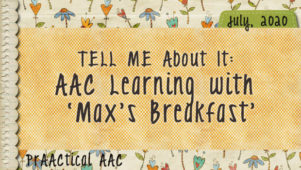
Welcome back to another installment of TELL ME About It, guest authored by Jeanna Antrim and Maggie Judson. Maggie and Jeanna are speech-language pathologists who work in the Assistive Technology Department for the Belleville Area Special Services Cooperative (BASSC) in southern Illinois. They are AT/AAC facilitators and provide evaluations, direct therapy, consultations, and trainings with school teams. In this series, they discuss how they support preschool teachers who are implementing the TELL ME program with their young students. Today, they walk us through the ways that they facilitate AAC use while focusing on the book ‘Max’s Breakfast’ Don’t miss their Lesson Plan, video demonstrations, and other resources at the end of the post. You can see their previous posts in the TELL ME About It series below. If You’re Angry and You Know It The Lunch Box Surprise Come Out and Play, Little Mouse No, David Go Away Big Green... [Read More...]
July 6, 2020
by Carole Zangari -
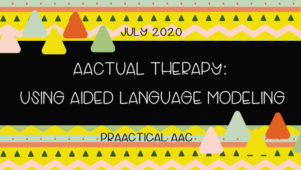
Although we’ve written extensively on the role of modeling in AAC, there are always new perspectives to consider regarding this evidence-based and widely-used strategy. Today, we feature SLPs Kate Grandbois and Amy Wonkka who share their approach to aided language modeling. :::::::::::::::::::::::::::::::::::::::::::::::::::::::::::::::::::::::: Bringing it all Together: Aided Language Modeling Most SLPs working in AAC have come across a variety of different interventions in their practice. Some, like aided language modeling, are popular and commonly seen at conferences. They are the most popular option on the intervention buffet. Others, like discrete trial training, are like the mystery meat – you think you know what it is, you don’t think you’re going to like it, and you’re going to watch while someone else tries it first. Sometimes these teaching procedures are straightforward, and sometimes they are confusing, intimidating, or complicated. You may find that choosing which intervention to use is influenced by... [Read More...]
June 8, 2020
by Carole Zangari -
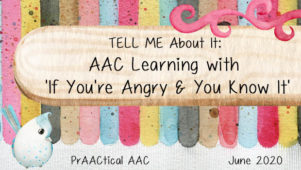
Welcome to a new edition of TELL ME ABout It, a series looking at ways to use children’s trade books to build AAC core vocabulary and literacy skills. Maggie Judson and Jeanna Antrim are back with more great ideas for AAC intervention, this time focusing on the book, ‘If You’re Angry and You Know It.’ Maggie and Jeanna are speech-language pathologists who work in the Assistive Technology Department for the Belleville Area Special Services Cooperative (BASSC) in central Illinois. They are AT/AAC facilitators and provide evaluations, direct therapy, consultations, and trainings. You can see their previous posts in the TELL ME About It series below. The Lunch Box Surprise Come Out and Play, Little Mouse No, David Go Away Big Green Monster What Do You Like? Here Are My Hands From Head to Toe I Went Walking Brown Bear, Brown Bear TELL ME AAC Literacy Kits Don’t miss their videos... [Read More...]
April 23, 2020
by Carole Zangari -
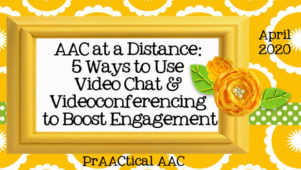
Like many of you, I have a love-hate relationship with video chat and videoconferencing these days. On one hand, we are immensely grateful for the technology that allows us to teach classes and hold meetings remotely so that we can continue with some semblance of our daily obligations. On the other hand, there is just no substitute for being in the same physical space as our co-workers, students, friends, and relatives. We are all adapting to this new reality of social distancing and experimenting with new ways of teaching, learning, and working. Across the globe, people are using video chat and videoconference technology, like FaceTime, Google Hangouts, and Zoom, in creative ways. If you’re looking for some ways to support AAC learners using these technologies, here are a few ideas. Hold a virtual Friendship Friday meeting: Invite a few classmates or friends to join an online meeting space to do... [Read More...]









